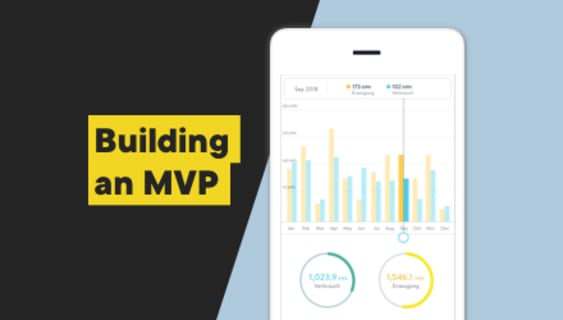How to Start Making Sales by Delivering the First Version of a Product
The first version of a product always faces additional challenges. It usually does not have enough recognition or a user base, while being the basis for estimating whether further development heads in the right direction. In this article, we will focus exactly on that – making sales by delivering the first version of a product. Do you wish to learn how to do that? Then keep reading.

Table of contents
How to start making sales by delivering an MVP?
MVP or a minimum viable product is the first version of a digital product introduced in the market with limited, basic functionality. It aims to attract the attention of the consumers and gather feedback from them, adjust the final product to the target audience’s needs, and eliminate potential weaknesses.
Even though it is designed to test the functions of a product, you can start making sales if you deliver it correctly. Yet, to do so, you have to begin planning before your digital product launch.
1. Understand your needs
Before the delivery, even before the order, you should answer one critical question – what is MVP for in your case? Which features do you want to test? What do you think that will achieve success among your target group? You need to have a thesis that your MVP will challenge.
To come up with that, you should adopt two strategies. Firstly, research your target audience. The more you know about their problems and pain points, the better solutions you will prepare. Secondly, analyze your competitors. Perhaps you can approach your potential users with a value that no other company offers.
While an MVP is basic, it does not mean it is random – you need to have a plan.
2. Come up with the features
Okay, so now it is time to create a plan. You know what, why, and how to tackle it. Now is the time to transfer it to your digital product.
We have used the word “transfer” for a reason – an idea has to be rewritten into an MVP. Together with the development team, you have to find ways to address the pain points of your audience and provide them with value, through the features of your app.
Not every solution is possible; sometimes, it might be too expensive to implement into an MVP. Therefore, we believe in consultations – intensive contact with the client, discussions, and research on what is possible and how it is possible.
An expert team of developers can suggest solutions that will work for your particular goals. You will be able to evaluate them and suggest modifications. Cooperation is thus crucial during this step. Even if you want to start with a simple e-commerce platform, it has to be easily scalable and intuitive for the users and your teams. To do that, you need to discuss not only the basic features but also the direction in which the app will head in the future.
3. Start a pre-launch marketing campaign
There are no sales without the clients. But, they need to know about a product to make a purchase.
If you wish to start making sales right away after making your MVP live, you need to come up with clever pre-launch app marketing. This serves three purposes:
- Creating product recognition
- Building excitement about your product
- Increasing the visibility of your product
Even if the purpose of your MVP is to acquire funding for further development, some marketing efforts are still a good choice. You will need them to prove that your product has potential. The more users you acquire during the MVP phase, the more you will sell.
4. Build a roadmap
Along with launching your first version of a product, you should offer your clients a roadmap. This will keep them excited about the future of the software.
This strategy will also help you increase your sales. If you purchase something, you have certain expectations, right? If there is no roadmap, your potential clients will have no idea about the direction in which your product will be developed. This may discourage many of them. But, with a clear-cut plan, there will be no mysteries – nobody will have to buy a pig in a poke.
5. Start free, finish premium
Take a look at Slack or DeepL – starting as free applications, they slowly headed towards a premium model, with DeepL recently introducing a limit of translated texts for free users (it is higher for the unregistered ones, but still restricted). If an application is good, then users will be willing to pay.
You can do the same with your MVP. Start free and introduce a premium subscription in one of the updates. While it won’t get you instant sales right after a launch, this is a profitable investment. You will build trust with the MVP, to gain high income on version 1.X.
How do we do it at Boldare?
While working on an e-commerce website for our esteemed client, The Elephant’s Trunk, they expressed their desire to publish and sell personalized children’s books. Given the client’s unique business idea, we recognized the importance of validating it as soon as possible. To achieve this, we collectively decided to adopt a Minimum Viable Product approach. In a Product Discovery workshop, the client and the entire product team prioritized all the essential features and elements of the website.
To expedite development without compromising on quality, we chose to leverage the Swell e-commerce platform, which offered many pre-built functionalities. This allowed us to launch a website faster with a limited number of books initially. This way, our clients could begin validating their idea and making sales promptly. Following the successful launch, we continued working on the second post-launch iteration, constantly expanding the website’s functionalities to support Teresa and Derek’s business growth.
Want to learn more? Check out our full Elephant’s Trunk case study!
Key takeaways
If you wish to start making sales by launching the first version of your product, you should begin planning your efforts way ahead of the launch. Choosing the features that match the technological capabilities and your business needs, conducting a pre-launch marketing campaign, building a roadmap, or even starting free to introduce premium subscriptions – all of these will help you begin making sales with your MVP and the future version of your app.
Want to see an MVP in practice? Check one of our case studies: How the Work Room app mixes with London’s coworking scene.
Share this article:








